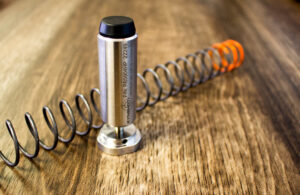Hydraulic buffer and spring
Over pressured gas guns can be frustrating, but let’s make them run correctly. There are three variables: gas, mass and spring.
In the AR platform, the gas that drives the system has several components which affect operation. First is the port pressure, which is determined by the location of the gas port on the barrel and which also determines the length of time the gas has to travel to effect operation of the bolt. Next, the size of the gas port, which determines gas volume introduced into the system. And lastly, the barrel length past the gas port, which determines the dwell time, or time that the system is pressurized. The pressure factor of the ammunition being fired is the last variable related to gas. However, it should be noted, that when using suppressors which have back pressure created by the baffle-chamber design most common in the industry, this effectively lengthens the barrel, often dramatically increasing the dwell time and creating additional prolonged pressure on the breach-face of the bolt.
The second part of the equation is mass. Mass equals buffer weight. This keeps your bcg locked up longer, creating more resistance and helping the gun cycle properly along with a tuned gas block. Also eliminating or reducing the negative effects on your brass.
Standard 308 carbine style buffers are 3.7oz, heavy buffers are around the 5 ounce mark and there are even heavier ones, such as the Kynshot hydraulic buffer we helped design, that only we sell.
The downside is if the buffer is too heavy it will hinder cycling and slow the cyclic rate down too much.
Last equation of a properly tuned AR is the spring. The buffer spring determines, similar to mass(buffer), how long the bolt carrier group “BCG” stays locked up. The spring comes into play just as much as the buffer weight, if not more so. This is because it helps return the bolt carrier back into battery. If too light, the bolt will travel too fast and cause malfunctions like double feeding.
We call the 3:30 to 4:00 o’clock case trajectory the optimal pattern, with a tight ejection pattern at 3:30-4 o’clock being the ultimate indication of both optimal and consistent BCG velocity. Benefits of achieving this highest state of tune is greatly enhanced reliability, less felt recoil, gun runs considerably cleaner (especially in suppressed DI guns), reducing maintenance, faster follow up shots and often increased accuracy from more consistent feeding and return to battery.
If you’re getting brass thrown forward from the 3:30-4:00(if your barrel was 12:00 O’clock) your gun is over gassed and needs to be tuned by one or all of these methods.
Other factors are ammunition. There are so many different types available and some have more pressure than others. Superperformance is one that has extra pressure, which needs to be adjusted with all three factors (gas block, mass, spring). We actually do not recommend this ammunition. We found it to be less accurate as well.
If you have an adjustable gas block and still have overpressure signs, look into our kynshot hydraulic buffer and springco heavy spring to help tune your AR properly.
